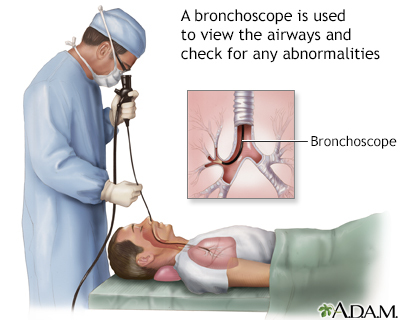Hypersensitivity pneumonitis
Definition
Hypersensitivity pneumonitis is inflammation of the lungs due to breathing in a foreign substance, usually certain types of dust, fungus, or molds.
Alternative Names
Extrinsic allergic alveolitis; Farmer's lung; Mushroom picker's disease; Humidifier or air-conditioner lung; Bird breeder's or bird fancier's lung
Causes
Hypersensitivity pneumonitis usually occurs in people who work in places where there are high levels of organic dusts, fungus, or molds.
Long-term exposure can lead to lung inflammation and acute lung disease. Over time, the acute condition turns into long-lasting (chronic) lung disease.
Hypersensitivity pneumonitis may also be caused by fungi or bacteria in humidifiers, heating systems, and air conditioners found in homes and offices. Exposure to certain chemicals, such as isocyanates or acid anhydrides, can also lead to hypersensitivity pneumonitis.
Examples of hypersensitivity pneumonitis include:
Bird fancier's lung: This is the most common type of hypersensitivity pneumonitis. It is caused by repeated or intense exposure to proteins found in the feathers or droppings of many species of birds.
Farmer's lung: This type of hypersensitivity pneumonitis is caused by exposure to dust from moldy hay, straw, and grain.
Symptoms
Symptoms of acute hypersensitivity pneumonitis often occur 4 to 6 hours after you have left the area where the offending substance is found. This makes it difficult to find a connection between your activity and the disease. Symptoms might resolve before you go back to the area where you encountered the substance. In the chronic phase of the condition, the symptoms are more constant and are less affected by exposure to the substance.
Symptoms after acute exposure may include:
- Chills
- Cough
- Fever
- Malaise (feeling ill)
- Shortness of breath
Symptoms of chronic hypersensitivity pneumonitis may include:
- Breathlessness, especially with activity
- Cough, often dry
- Loss of appetite
- Unintentional weight loss
Exams and Tests
The health care provider will perform a physical examination and ask about your symptoms.
Your provider may hear abnormal lung sounds called crackles (rales) when listening to your chest with a stethoscope.
Lung changes due to chronic hypersensitivity pneumonitis may be seen on a chest x-ray. Other tests may include:
- Aspergillosis precipitin blood test to check if you've been exposed to the aspergillus fungus
- Bronchoscopy with washings, biopsy, and bronchoalveolar lavage
- Complete blood count (CBC)
- CT scan of the chest
- Hypersensitivity pneumonitis antibody panel blood test
- Krebs von den Lungen-6 assay (KL-6) blood test
- Pulmonary function tests
- Surgical lung biopsy
Treatment
First, the offending substance must be identified. Treatment involves avoiding this substance in the future. Some people may need to change jobs if they cannot avoid the substance at work.
If you have a chronic form of this disease, your doctor may recommend that you take glucocorticoids (anti-inflammatory medicines). Sometimes, treatments used for asthma can help people with hypersensitivity pneumonitis.
Outlook (Prognosis)
Most symptoms go away when you avoid or limit your exposure to the material that caused the problem. If prevention is made in the acute stage, the outlook is good. When it reaches the chronic stage, the disease might continue to progress, even if the offending substance is avoided.
Possible Complications
The chronic form of this disease may lead to pulmonary fibrosis. This is a scarring of the lung tissue that often is not reversible. Eventually, end-stage lung disease and respiratory failure can occur. Some people might need lung transplantation at the end-stage of the disease.
When to Contact a Medical Professional
Contact your provider if you develop symptoms of hypersensitivity pneumonitis.
Prevention
The chronic form can be prevented by avoiding the material that causes the lung inflammation.
Gallery


References
Johannson KA, Fernandez Perez ER. Hypersensitivity pneumonitis. In: Broaddus VC, Ernst JD, King TE, et al, eds. Murray and Nadel's Textbook of Respiratory Medicine. 7th ed. Philadelphia, PA: Elsevier; 2022:chap 91.
Tarlo SM. Occupational lung disease. In: Goldman L, Schafer AI, eds. Goldman-Cecil Medicine. 26th ed. Philadelphia, PA: Elsevier; 2020:chap 87.